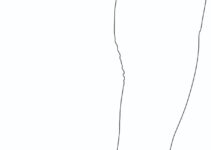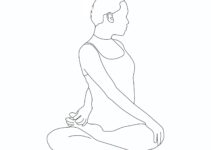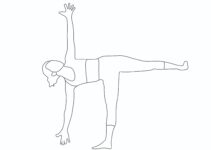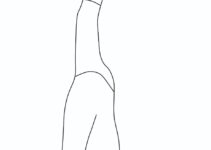Meaning of asana
- The word ‘Asana’ is etymologically derived from the Sanskrit root ‘as’, which means to sit.
- Monier Williams has given a relatively long list of meanings associated with the word ‘Asana’: ‘to be present; to exist; to inhabit; dwell in; to make one abode in….; to sit quietly, abide, to continue in any situation.
- Yoga asanas in Yogasadhana usually indicate the ‘sitting posture’ or ‘position’ of the body, which contributes to the steadiness of the body and mind and a sense of well-being.
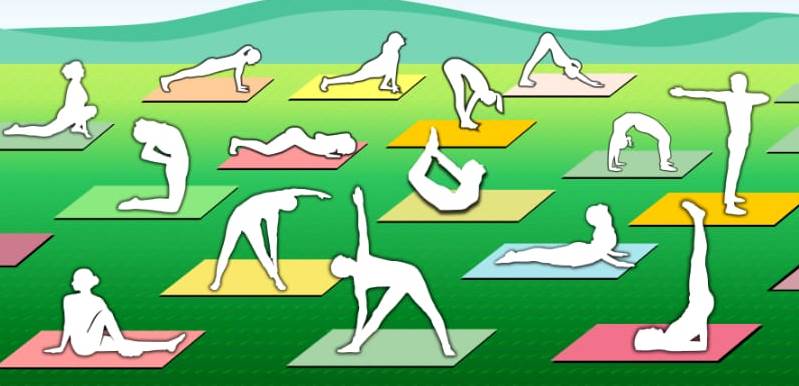
Asanas
What Patanjali says about asana?
- Patanjali has defined Asana as a position or bodily posture that confirms steadiness (hairy) and is equally pleasant and comfortable (sukham).
- It is clear from this definition that any body posture, which can be maintained steadily for a long time, can be called. Thus, stability and comfort are the main characteristics of Asana.
- Patanjali has stated that to achieve steadiness and comfort, asana must be without any muscular or nervous tension, and the mind should be merged with Ananta (infinity).
Asana as per Siddhasiddhantapaddhati
Siddhasiddhantapaddhati (900 A.D.-1000 A.D.), an essential text of Hathayoga, emphasises ‘one’s steadiness in one’s form’ as the chief characteristic of asana.
Yoga asana as per Hathapradipika
- According to Hathapradipika, asana brings mental and physical health and a feeling of lightness.
- It also provides a disease-less body and happiness.
Asanas as per Yogarasayana
- The text Yogarasayana states that asana is essential to undergo other yogic practices.
- It brings stability to the body, without which one cannot have a stable mind.
- When asana becomes stable, the mind gains stability; the movement of Praṇa slows down, and the senses’ fickleness is set at rest; then one gets established in Yoga.
Asanas in Traditional Yoga Textbooks
Regarding the number of asanas, different traditional Yoga texts have different opinions. Patanjali in Yogasutra has neither mentioned the name of any asana to be adopted by the practitioners nor has he given any instruction about the technique.
Vyasabhasya
Vyasabhasya (500 AD- 600 AD), the first authentic commentary on Yogasutra, mentioned 11 asanas which can be practised comfortably and steadily. The asanas given in Vyasabhasya are:
- Padmasana 7. Paryankasana
- Virasana 8. Krauncanisadanasana
- Bhadrasana 9. Hastinisadanasana
- Swastikasana 10. Ustranisadanasana
- Dandasana 11. Samasthanasana
- Sopasrayasana
Yogavartika
Vijnanabiksu, the author of Yogavartika (1400 AD), has specified the names and techniques of the four asanas, calling them Asanacatustaya (Y.V.: 2/46). The four asanas are:
- Padmasana
- Virasana
- Bhadrasana
- Swastikasana
Gherandasamhita
Gorakṣasanath (900 AD-1000 AD) in Goraksasatakam and Gherandarsi (1800 AD) in Gherandasamhita mention that there are as many asanas as the number of living species. The number of such species is 84 lakhs, and accordingly, the number of asanas is 84 lakhs. Of 84 lakh asanas, 84 have been considered very useful and taught by Shiva. Gherandarishi in Gherandasamhita found thirty-two asanas (out of eighty-four asanas) beneficial for human beings.
- Siddhasana 17. Utkatasana
- Padmasana 18. Saṅkatasana
- Bhadrasana 19. Mayurasana
- Muktasana 20. Kukkutasana
- Vajrasana 21. Kurmasana
- Swastikasana 22. Uttanakurmasana
- Siṁhasana 23. Uttanamandukasana
- Gomukhasana 24. Virkshasana
- Virasana 25. Mandukasana
- Dhanurasana 26. Garudasana
- Savasana 27. Ṛsabhasana
- Guptasana 28. Shalabhasana
- Matsyasana 29. Makarasana
- Matsyendrasana 30. Ushtrasana
- Gorakshasana 31. Bhujangasana
- Pashcimottanasana 32. Yogasana
Hathapradipika
Regarding the details of asanas, the Hathayoga treatises provide comprehensive descriptions of the performance of the asanas. Svatmarama, the author of Hathapradipika (1400 AD), has given the details of the following 15 asanas:
- Swastikasana 9. Paschimottanasana
- Gomukhasana 10. Mayurasana
- Virasana 11. Savasana
- Kurmasana 12. Siddhasana
- Kukkutasana 13. Padmasana
- Uttanakurmasana 14. Simhasana
- Dhanurasana 15. Bhadrasana
- Matsyendrasana
Yogatattvopanisad
Yogatattvopanisad (1400 AD – 1500 AD) describes asanas as one of the twenty components of Hatha yoga and prescribes four asanas (Siddhasana, Padmasana, Simhasana and Bhadrasana), which are explained in Hathapradipika.
Hatharatnavali
Hatharatnavali (1600 AD – 1700 AD) mentions the names of eighty-four asanas but describes the technique of the following thirty-seven asanas only:
- Siddhasana 20. Markatasana
- Bhadrasana 21. Matsyendrasana
- Simhasana 22. Parsvamatsyendrasana
- Padmasana 23. Baddhamatsyendrasana
- Karasamputitapankajam 24. Niralambanamasana
- Mayurasana 25. Saurasana
- Dandamayurasana 26. Ekpadasana
- Parsvamayurasana 27. Phanidrasana
- Baddhakekiasana 28. Paschimottanasana
- Pindmayurasana 29. Sayitapascimattanasana
- Ekpadamayurasana 30. Vicitrakaraniasana
- Bhairavasana 31. Yoganidrasana
- Kamadahanasana 32. Vidhunasana
- Panipatrasana 33. Padapithasana
- Dhanurasana 34. Kukkutasana
- Gomukhasana 35. Uttanakurmasana
- Swastikasana 36. Virschikasana
- Virasana 37. Savasana
- Mandukasana
Siddhasiddhantapaddhati
According to Siddhasiddhantapaddhati, one should adopt any Swastikasana, Padmasana, and Siddhasana posture.
Vashisthasamhita
Vashisthasamhita has given the techniques of the following 10 asanas:
| 1 | Svastikasana | 6 | Mayurasana |
| 2 | Gomukhasana | 7 | Kukkutasana |
| 3 | Padmasana | 8 | Bhadrasana |
| 4 | Virasana | 9 | Kurmasana |
| 5 | Simhasana | 10 | Muktasana |
Shivsamhita
Shivsamhita refers to the following four asanas with technique:
- Siddhasana
- Ugrasana
- Padmasana
- Svastikasana
Yogayajnavalkyasamhita
Yogayajnavalkyasamhita prescribes the following eight asanas with techniques.
| 1 | Svastikasana | 5 | Simhasana |
| 2 | Gomukhasana | 6 | Bhadrasana |
| 3 | Padmasana | 7 | Muktasana |
| 4 | Virasana | 8 | Mayurasana |
Hathatattvakaumudi
Hathatattvakaumudi, another Hatha yogic text of the later period of Sunderdeva, prescribes the following 15 asanas along with their technique.
| 1 | Dhanurasana | 9 | Kurmasana |
| 2 | Kukkutasana | 10 | Prasaritasana |
| 3 | Matsyendrasana (Matsyendrapitham) | 11 | Padmasana (amburuhasana/Sororahasana/Ambujasana) |
| 4 | Mayūrasana (Mayurpitha) | 12 | Baddhapadmasana |
| 5 | Savasana | 13 | Siddhasana (YonyAsana) |
| 6 | Simhasana (Yogasimhasana) | 14 | Pascimatanasana |
| 7 | Bhadrasana
| 15 | Svastikasana |
| 8 | Virasana |


